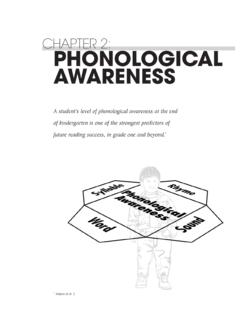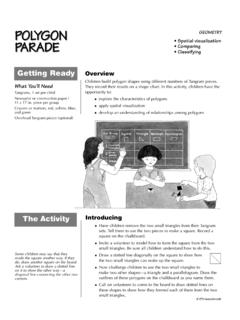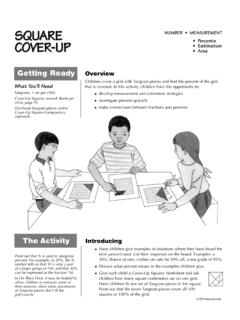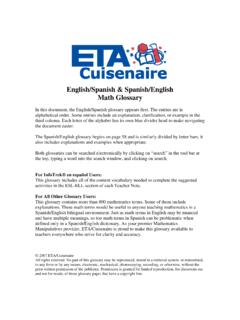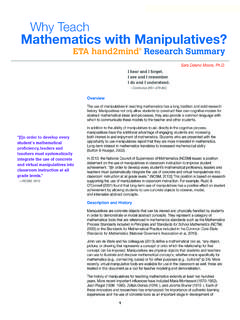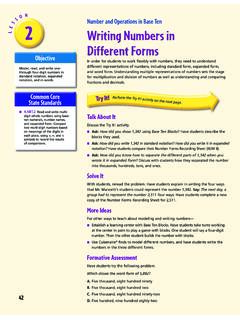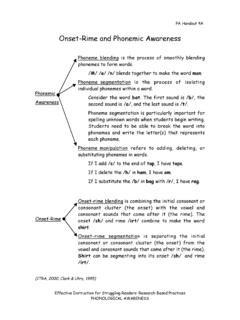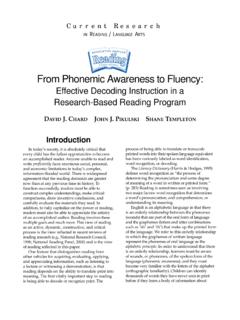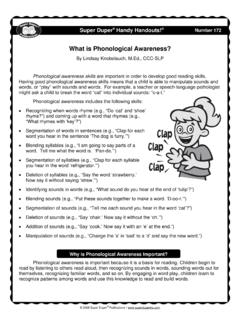Transcription of CHAPTER 2: PHONOLOGICAL AWARENESS - hand2mind
1 CHAPTER 2: PHONOLOGICAL . AWARENESS . A student's level of PHONOLOGICAL AWARENESS at the end of kindergarten is one of the strongest predictors of future reading success, in grade one and beyond.*. *. Adams et al. 2. Research on PHONOLOGICAL Find Out More About PHONOLOGICAL AWARENESS AWARENESS Adams, M. J., B. R. Foorman, I. Lundberg, and T. In recent years, many researchers have explored the relationship Beeler. Phonemic AWARENESS in Young Children: between PHONOLOGICAL AWARENESS and success with reading and A Classroom Curriculum. Paul Brookes Publishing spelling. PHONOLOGICAL AWARENESS is the area of oral language Co., 1998. that relates to the ability to think about the sounds in a word Bear, Donald, Marcia Invernizzi, Shane Templeton, (the word's PHONOLOGICAL structure) rather than just the meaning and Francine Johnston.
2 Words Their Way. 3d ed. of the word. It is an understanding of the structure of spoken Prentice Hall, 2003. language that it is made up of words, and words consist of Cunningham, James W, Patricia M. Cunningham, syllables, rhymes, and sounds. Fitzpatrick summarizes it best by James V. Hoffman, and Hallie K. Yopp. Phonemic saying that PHONOLOGICAL AWARENESS is the ability to listen inside AWARENESS and the Teaching of Reading: A Position a word (5). Statement from the Board of Directors of the Children who have well-developed PHONOLOGICAL AWARENESS International Reading Association. International when they come to school have a head start making sense of Reading Association, 1998.
3 How sounds and letters operate in print. This ability is important Fitzpatrick, J. Phonemic AWARENESS : Playing With for using sound-letter knowledge effectively in reading and Sounds to Strengthen Beginning Reading Skills. writing. In fact, a student's level of PHONOLOGICAL AWARENESS at the Creative Teaching Press, 1997. end of kindergarten is one of the strongest predictors of future Goswami, U., and P. Bryant. PHONOLOGICAL Skills and reading success, in grade one and beyond. Many children begin Learning to Read. Psychology Press, 1990. kindergarten with well-developed PHONOLOGICAL AWARENESS . Some Grif th, Priscilla L., and Mary W.
4 Olson. Phonemic seem to develop these skills fairly easily within a stimulating AWARENESS Helps Beginning Readers Break the classroom environment, while others need more instruction that Code. The Reading Teacher (1992): 516 23. consciously and deliberately focuses on PHONOLOGICAL AWARENESS . Gunning, Thomas. Word Building: A Strategic More than 20 percent of students struggle with some aspects of Approach to the Teaching of Phonics. The Reading PHONOLOGICAL AWARENESS , while 8 10 percent exhibit signi cant Teacher (1995): 484 88. delays. Early intervention is crucial and can make a real difference Juliebo, Moira F., and Lita Ericson.
5 The PHONOLOGICAL to students with limited levels of PHONOLOGICAL AWARENESS . AWARENESS Handbook for Kindergarten and Primary (See CHAPTER 5: Early Intervention for Students At Risk.) Teachers. International Reading Association, 1998. Pinnell, G., and I. Fountas. Word Matters. Heinemann, 1998. The Development of Snow, Catherine E., M. Susan Burns, and Peg Grif n, PHONOLOGICAL AWARENESS eds. Preventing Reading Dif culties in Young Children. National Academy Press, 1998. We know that many children rst demonstrate PHONOLOGICAL Yopp, Hallie K. Developing Phonemic AWARENESS AWARENESS as preschoolers. They begin to recognize words as in Young Children.
6 The Reading Teacher separate entities ( , What does the mean?). They also become (1992): 696 703. aware of how groups of sounds (syllables or rhymes) operate . A Test for Assessing Phonemic AWARENESS in words in spoken language ( , Matt and pat rhyme). They in Young Children. The Reading Teacher develop an AWARENESS of individual sounds and can attend to (1995): 20 29. and manipulate them in a word ( , Dad and dear they start the same). These individual sounds of a language are known as phonemes. PHONOLOGICAL AWARENESS 117. PHONOLOGICAL refers to an AWARENESS Expected PHONOLOGICAL AWARENESS Skills in Kindergarten understanding of the By the end of kindergarten, given suf cient instruction, sound structure of practice, and exposure to many literacy activities, students language that is, that should be able to language is made up of Word level: words, syllables, rhymes, recognize how many words are in a sentence and sounds (phonemes).
7 Syllable level: This knowledge occurs segment and blend words of at least three syllables initially in oral language; Rhyme level: students do not have to understand the concept of rhyming know how to name recognize and generate rhyming words letters or their Sound level: corresponding sounds in isolate the beginning or ending sounds in words order to demonstrate segment and blend sounds in a word with three sounds PHONOLOGICAL AWARENESS . change a sound in a word to make a new word in familiar games and songs Phonemic AWARENESS is one component of An important link in developing PHONOLOGICAL AWARENESS is to encourage students to use invented or temporary spelling.
8 PHONOLOGICAL AWARENESS . When students attempt to write a word, they must rst listen It refers to knowledge to their own language, segment the sounds in the word, and of words at the level nally, try to match the sounds with known letters. Students need of individual sounds some PHONOLOGICAL AWARENESS to use invented spelling, but their how to segment, blend, exploration of sounds through writing helps them to discover more or manipulate individual about how sounds and letters work in English, and then how to sounds in words. use this knowledge as they read. Phonics refers to an The Role of understanding of the PHONOLOGICAL AWARENESS sound and letter relationships in a There are different levels of PHONOLOGICAL AWARENESS within words: language.
9 PHONOLOGICAL syllables, onsets and rimes, and sounds. Recognizing this has AWARENESS is necessary important implications for supporting students' development in order to use this of PHONOLOGICAL AWARENESS . Good readers look for familiar phonics knowledge letter patterns as one strategy when attempting to decode or effectively in reading spell unfamiliar words they use familiar sound chunks from and writing. known words, not just individual sounds. Thomas Gunning says that students look for pronounceable word parts (484). This chunking of sounds makes the reading and spelling process much more effective and ef cient. These letter patterns are based on familiar syllable or rhyme patterns as well as sound clusters and individual sounds.
10 This ability to look inside words for syllables, rhymes, and individual sounds when reading and spelling is based on the 118 COMPREHENSIVE LITERACY RESOURCE FOR KINDERGARTEN TEACHERS. student's PHONOLOGICAL AWARENESS . Students have to be able to segment, blend, and manipulate syllables, onset and rime, and Words can be divided into onsets and rimes. sounds if they are going to be successful in using letter-sound The onset refers to knowledge effectively for reading and writing. The PHONOLOGICAL any sounds before the AWARENESS skills of segmenting and blending are the most highly vowel; the rime is any correlated with beginning reading acquisition (Snow 192).
